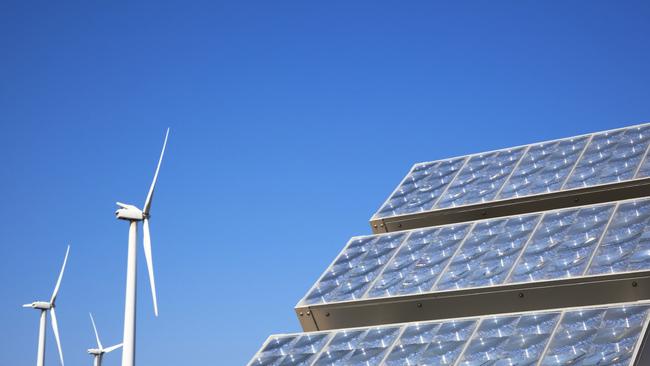Fall in electricity prices by 2023 forecast by Australian Energy Market Commission modelling
Average household bills will increase by $20 next financial year as the NSW Liddell generator exits, but renewables will see bills fall the following year, new modelling indicates.

Australia faces a short-term hit from the looming closure of AGL Energy’s Liddell coal plant with a lift in residential bills in 2022-23 to be sharply reversed the following year as renewable energy fills the gap left by its retirement.
National prices will fall by a modest $4 a year by 2021-22 with a $20 increase in 2022-23 as Liddell exits that summer, followed by a substantial $92 drop by 2023-24, according to new modelling released on Thursday by the Australian Energy Market Commission.
Households across the national electricity market are expected to see a decline in their power bills of $77 or 6 per cent on average by 2024 compared with 2020-21 costs, due to growing renewable supplies and lower green subsidies for the clean energy source.
While NSW will endure a 7 per cent or $92 increase in its average residential bills from this year to 2022-23, overall electricity prices in the nation’s most populous state are forecast to fall by 4 per cent or $50 over the three-year period to 2023-24.
“We can now see far enough into the future to be confident that power prices paid by consumers will continue to trend downwards over the next three years, despite the staged exit of Liddell power station in 2022 and 2023, one of the biggest coal-fired generators in the national electricity market,” AEMC chair Anna Collyer said.
Growing solar, wind and storage generation will help offset Liddell’s 1680 megawatts of lost capacity. “While we have just under 2500MW of generation expected to exit the grid over the next three years, there are almost 5500MW of committed new large-scale generation and storage projects coming online over the same time period,” Ms Collyer said.
“This is in addition to 4130MW of new rooftop solar PV capacity, which will also influence prices by lowering demand and through exports.”
Victoria’s average power prices will fall 8 per cent, with southeast Queensland to decline 10 per cent, South Australia decreasing 2 per cent and ACT will see a 4 per cent increase out to 2023-24.
Tasmania will drop by 6 per cent or $125 on average over the three years to 2023-24.
Independent modelling for the government’s Liddell Taskforce showed that if the power station were not replaced, NSW average wholesale prices could rise from the low $60 per megawatt hour in 2022 to about $80MWh in 2024 and continue increasing to $105MWh by 2030.
The future of the near half-century old plant – which provides 10 per cent of the state’s power – has proved politically contentious for several years after former prime minister Malcolm Turnbull fought a bitter brawl with AGL to delay its closure or sell it to other suitors that would invest in its extension.
Energy Minister Angus Taylor said pressure on prices was in part due to the federal government-owned Snowy Hydro proceeding with its giant hydro expansion and new gas plant in Kurri Kurri, near Newcastle.
“Importantly this report shows that government’s support for new on-demand dispatchable generation, like Snowy 2.0 and the Hunter Power Project gas generator at Kurri Kurri, will put downward pressure on prices as ageing thermal generation retires,” Mr Taylor said.
While both wholesale and green energy costs are expected to fall through to 2023-24, the AEMC warned that network costs would increase by $31 over the three-year period amid a need to build infrastructure to help move new sources of energy supplies around the power grid.
“While wholesale costs and environmental costs are trending lower, we are starting to see increases in the cost of network investments, and this is likely to accelerate over the next decade as more network investment is required to connect dispersed new generation to the grid,” Ms Collyer said.
Coal, which provides up to 70 per cent of electricity, will contribute less than a third of supply by 2040, Australian Energy Market Operator forecasts show.
Up to 19GW of firmed dispatchable resources such as gas, pumped hydro and batteries will be required in the next two decades to back up renewables in Australia, forecasts show.
Big utilities including AGL, Origin Energy and EnergyAustralia are being battered by a storm of low wholesale electricity prices as wind and solar supplies continue to be developed, while moves by state and federal governments to underwrite new generation has also depressed market conditions.
However, that same pressure on wholesale prices has resulted in a sustained period of lower tariffs for most Australian households after several years of high prices following the closure of the Hazelwood coal plant in Victoria’s Latrobe Valley.
AGL grabbed an extra $832m or 60 per cent jump in gross profits from its wholesale electricity business after the closure of the Hazelwood brown coal-fired power plant in 2017, according to analysis by the Victoria Energy Policy Centre.
The retirement of the facility with just four months’ notice caused turmoil in the national electricity market. About a quarter of supply was shuttered, which large power retailers then capitalised on through their dominant market positions.


To join the conversation, please log in. Don't have an account? Register
Join the conversation, you are commenting as Logout